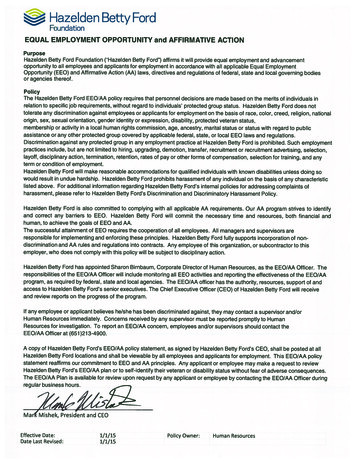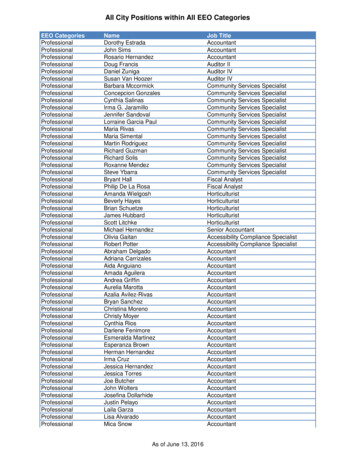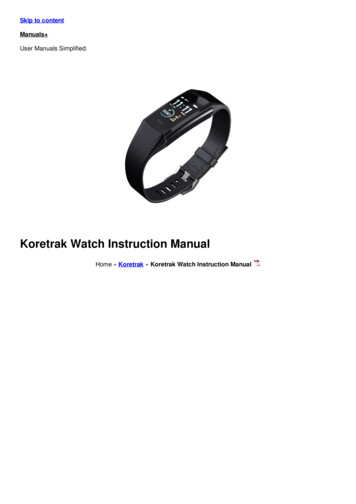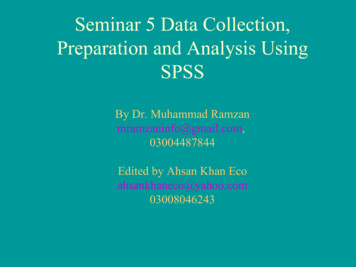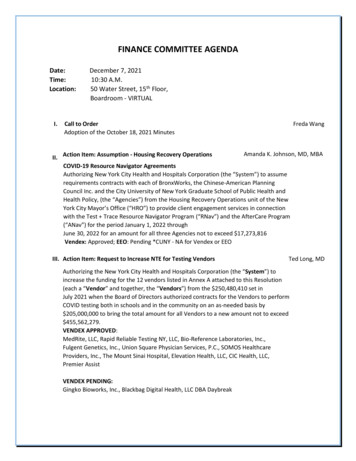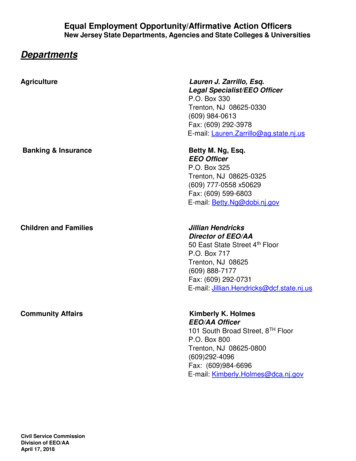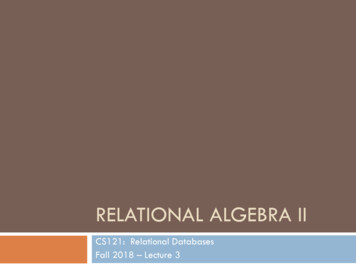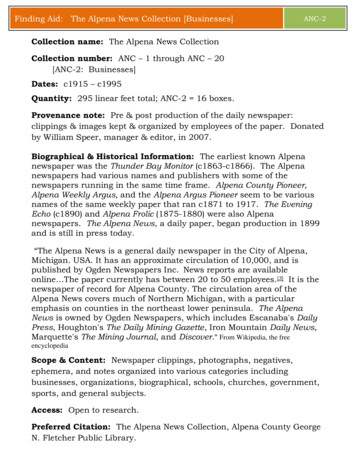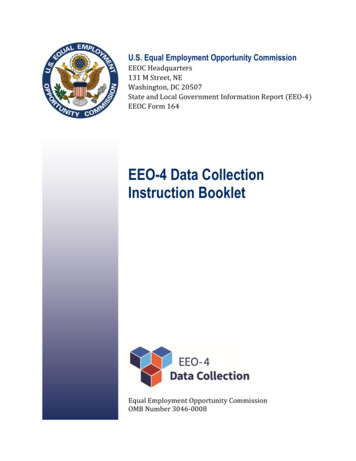
Transcription
U.S. Equal Employment Opportunity CommissionEEOC Headquarters131 M Street, NEWashington, DC 20507State and Local Government Information Report (EEO-4)EEOC Form 164EEO-4 Data CollectionInstruction BookletEqual Employment Opportunity CommissionOMB Number 3046-0008
OMB Control No. 3046-0008EQUAL EMPLOYMENT OPPORTUNITY COMMISSIONCOLLECTION OF 2021 EEO-4 DATAState and Local Government Information Report (EEO-4)EEOC Form 164INSTRUCTION BOOKLETFor ease of navigation, this document includes hyperlinks to help navigate between thetable of contents and each section. To visit a section of the document, click on the relevanttitle in the table of contents. You will be able to click the return to Table of Contents link atthe top of each page to return to the table of contents.2EEO-4 Data Collection
Table of Contents1.Who Must File. 43.When to File . 52.4.5.How to File . 4Instructions for Filing EEO-4 Reports . 5Data to be Reported in EEO-4 Report . 6A. Type of Government . 6B. Identification . 6C. Function . 6D. Employment Data as of June 30th . 8E. Departments/Agencies Included in This Report . 10F. Departments/Agencies Not Included in This Report . 106.7.8.9.G. Remarks . 10Certification . 11Confidentiality . 12Exemption from Reporting Requirements . 12Burden Estimate . 12Appendix 1. Definitions. 13Appendix 2. Description of Job Categories . 14Appendix 3. Definitions of Race/Ethnicity Categories . 16Appendix 4. Annual Salary Categories . 18Appendix 5. Legal Basis for Reporting Requirements . 183EEO-4 Data Collection
Return to Table of ContentsOMB Control No. 3046-0008EQUAL EMPLOYMENT OPPORTUNITY COMMISSIONCOLLECTION OF 2021 EEO-4 DATASTATE AND LOCAL GOVERNMENT INFORMATION REPORT (EEO-4)EEOC FORM 1641.WHO MUST FILEINSTRUCTION BOOKLETThe State and Local Government Information Report (EEO-4), EEOC Form 164, alsoreferred to as the EEO-4 Report, is a mandatory biennial data collection that requires allState and local governments with 100 or more employees to submit demographicworkforce data, including data by race/ethnicity, sex, job category, and salary band. Thefiling by eligible State and local governments is required under section 709(c) of Title VII ofthe Civil Rights Act of 1964, as amended, 42 U.S.C. 2000e-8(c), 29 CFR 1602.30 and .32-.37.See Appendix 5 below for additional information.Section 709(c) of Title VII of the Civil Rights Act of 1964, as amended, 42 U.S.C. 2000e-8(c),requires employers to make and keep records relevant to a determination of whetherunlawful employment practices have been or are being committed, to preserve suchrecords, and to produce reports as the Commission prescribes by regulation or order.Accordingly, the EEOC has issued regulations, 29 CFR 1602.30 and .32-.37, prescribing thereporting and related record retention requirements for State and local governments. 29CFR 1602.30 requires every covered State and local government to make or keep allrecords necessary for completion of an EEO-4 submission and retain those records forthree years. 29 CFR 1602.32 requires EEO-4 filers to retain a copy of each filed EEO-4report for three years. See Appendix 5 below for additional information.2.HOW TO FILEEEO-4 reporting is an electronic, online application. The EEOC requires that the 2021 EEO4 Reports be submitted via the new EEO-4 Online Filing System athttps://EEOCdata.org/eeo4. Data can be entered directly into the online application orsubmitted as an electronically transmitted data file (i.e., data file upload) through the EEO4 Online Filing System. Detailed data file upload instructions will be available athttps://eeocdata.org/EEO4/howto/upload. Filers can begin submitting data for the 2021EEO-4 data collection through the EEO-4 Online Filing System on Tuesday, October 26,2021.4EEO-4 Data Collection
3.WHEN TO FILE4.INSTRUCTIONS FOR FILING EEO-4 REPORTSReturn to Table of ContentsThe 2021 EEO-4 data collection will open on Tuesday, October 26, 2021. The EEO-4 Reportfor calendar year 2021 must be filed no later than Tuesday, January 4, 2022. This filingdeadline date is posted on the EEOC’s dedicated website for the EEO-4 data collectionat https://EEOCdata.org/eeo4, and on the EEOC’s public website at www.eeoc.gov.State and local governments must file EEO-4 reports according to the number of full-timeemployees on the payroll during the period covering June 30th of the reporting year (i.e.,2021).In those jurisdictions where all data are available at a single location, all reports may becompleted by the central office. Where data are not available centrally, data should beobtained by the central office from all departments/agencies and aggregated into therelevant report by function.The fact that a branch or agency of a government has separately elected officials or isautonomous or semi-autonomous in its operations does not affect the legal status of thejurisdiction, nor the requirement that the EEO-4 covers the entire jurisdiction. To theextent feasible, the report should cover all branches of the government. In any cases wherethat is not feasible, and data are not available to the central office of the government, thejurisdiction should list the name and address of each department/agency for which datahas not been included under section 5 F. Departments/Agencies Not Included in ThisReport (see below).Where interstate, intercounty, boards, agencies, commissions, or other types of specialdistrict governments exist, one report should be submitted by the headquarters of thespecial district for each function performed.Instructions for All Jurisdictions(1) All State and local governments must file one report for each function listed undersection 5 C. Function (see below) (if that function is performed) for a maximum of15 function reports. Jurisdictions should only report employees on the jurisdiction’spayroll during the relevant period (i.e., payroll period covering June 30th of thereporting year). For the 2021 EEO-4 Report, the reporting year is 2021.(2) Additionally, for each function report, the jurisdiction should list the departments oragencies that perform the function indicated in the report under section 5 E.Departments/Agencies Included in This Report (see below). For example, Function1 “Financial Administration” and “General Control” might include the followingdepartments/agencies: Office of the Tax Collector, Office of the Mayor, Office of theDistrict Attorney, etc. Jurisdictions should also include under that section, theNational Crime Information Center (NCIC) numbers assigned by the U.S.5EEO-4 Data Collection
Return to Table of ContentsDepartment of Justice to any criminal justice departments/agencies whose data areincluded in this report.(3) If a jurisdiction cannot supply the data for every department or agency with thebelow functions, the jurisdiction should list the name and address of eachdepartment or agency for which data has not been included in the report undersection 5 F. Departments/Agencies Not Included in This Report (see below).5.DATA TO BE REPORTED IN EEO-4 REPORTA. Type of GovernmentUnder this section, the filer must select only one of the following (i.e., type of Special District(6)Other (Specify)Note: If filers select “other,” please specify what type of government best identifiesyour political jurisdiction.B.IdentificationUnder this section, the political jurisdiction must provide the following information:(1) Name of Political Jurisdiction(2) Mailing AddressNote: Filers should provide the central mailing address of the political jurisdiction.(3) City/Town(4) County(5) State(6) Zip CodeC.FunctionIndicate which jurisdiction function(s) is(are) performed by the employees on the report.A jurisdiction must file one report for each function listed below (if that function isperformed) for a maximum of 15 function reports.List of 15 Functions(1) Financial Administration. Tax billing and collection, budgeting, purchasing, centralaccounting and similar financial administration carried on by a treasurer’s,auditor’s or comptroller’s office and;6EEO-4 Data Collection
Return to Table of ContentsGeneral Control. Duties usually performed by boards of supervisors orcommissioners, central administration offices and agencies, central personnel orplanning agencies, all judicial offices and employees (judges, magistrates, bailiffs,et al.).(2) Streets and Highways. Maintenance, repair, construction and administration ofstreets, alleys, sidewalks, roads, highways, and bridges.(3) Public Welfare. Maintenance of homes and other institutions for the needy;administration of public assistance. (Hospitals should be reported under Functionnumber 7 below).(4) Police Protection. Duties of a police department sheriff’s, constable’s, coroner’soffice, etc. Including technical and clerical employees engaged in police activities.(5) Fire Protection. Duties of the uniformed fire force and clerical employees. (Reportany forest fire protection activities in Function number 6 below).(6) Natural Resources. Agriculture, forestry, forest fire protection, irrigation drainage,flood control, etc., and;Parks and Recreation. Provision, maintenance and operation of parks,playgrounds, swimming pools, auditoriums, museums, marinas, zoos, etc.(7) Hospitals. Operation and maintenance of institutions for inpatient medical care.(8) Health. Provision of public health services, outpatient clinics, visiting nurses, foodand sanitary inspections, mental health, alcohol rehabilitation service, etc.(9) Housing. Code enforcement, low rent public housing, fair housing ordinanceenforcement, housing for elderly, housing rehabilitation, rent control.(10) Community Development. Planning, zoning, land development, open space,beautification, preservation.(11) Corrections. Jails, reformatories, detention homes, halfway houses, prisons, paroleand probation activities.(12) Utilities and Transportation. Includes water supply, electric power, transit, gas,airports, water transportation and terminals.(13) Sanitation and Sewage. Street cleaning, garbage and refuse collection and disposal.Provision, maintenance and operation of sanitary and storm sewer systems andsewage disposal plants.(14) Employment Security. State governments only.(15) Other. (Specify).7EEO-4 Data Collection
Return to Table of ContentsNote: If a jurisdiction selects “other,” please list the function(s) performed underthis selection.The data reported for the above functions should be aggregated for all the performingdepartments or agencies within the particular function. This also applies to unspecifiedfunctions which are to be combined for Function 15 “Other” above. Any jurisdictionsreporting employees under Function 15 “Other” should also list these unspecifiedfunctions. State education agencies (both agencies covering elementary and secondaryschools and those covering education) should be included in Function 15 “Other” above.However, data for public elementary and secondary school systems and districts should notbe included in the EEO-4 Report. The EEOC collects such data separately under the EEO-5Elementary-Secondary Staff Information Report. Additional information regarding theEEO-5 Report can be found at https://EEOCdata.org/eeo5.Where the jurisdiction is unable to separate data, the department or agency should bereported under the function that represents it dominant activity. For example, if atransportation department includes, among other functions, streets and highways, andtwo-thirds of the employees of the department are engaged in street and highwayactivities, those employees should be separated out and reported separately if feasible. Ifnot, the entire department should be reported separately under Function 2 “Streets andHighways” above.D. Employment Data as of June 30thEmployment data used for the 2021 EEO-4 report must be provided as of June 30th of thereporting year (i.e., 2021). The employment status that full-time and part-time employeesare reported under, must also be based on their employment as of June 30th of thereporting year (i.e., 2021).For purposes of the EEO-4 report, a person is an employee of a political jurisdiction if theemployee is on the payroll of that jurisdiction, regardless of the source of the funds bywhich the employee is paid.Relevant Reporting Periods for EEO-4 Employee DataFull-time Employee Data: Full-time employee data should cover the payroll period whichincludes June 30th of the reporting year (i.e., 2021).Part-time Employee Data: Part-time employee data should cover the payroll period whichincludes June 30th of the reporting year (i.e., 2021).New Permanent Full-Time Hires Data: Filers must provide a breakout of new permanentfull-time hires during the fiscal year (i.e., July 1st, 2020 – June 30th, 2021). Data for such newhires covers the entire fiscal year which ends on June 30th of the reporting year (i.e., 2021).The relevant time period for the 2021 reporting year would be July 1st, 2020 – June 30th,2021.8EEO-4 Data Collection
Return to Table of ContentsPlease note that the data for new hires only includes permanent full-time new hires. Parttime/temporary new hires would not be included in the “New Hires during Fiscal Year”sub-section under section 5 D. Employment Data as of June 30th. However, any newpermanent full-time hires covered by the payroll period which includes June 30th, 2021,should also be included in the “Full-Time Employees” sub-section under section 5 D.Employment Data as of June 30th.Full-time EmployeesEmployee data under this sub-section (i.e., Full-time Employees) should include total fulltime employees except for certain exempted elected and appointed officials describedbelow in Appendix 1. Where employees receive separate salaries or payments from two ormore jurisdictions, but work full-time for one jurisdiction, those employees should becounted as full-time employees by that jurisdiction. Additionally, those employees’ annualsalaries, to the extent possible, should reflect their total earnings from all jurisdictions fromwhich they are paid. Also, where a person is a full-time employee of a jurisdiction, but isemployed in more than one function, the employee should be reported for the functionwhich accounts for most of the employee’s worktime. Trainees should be counted in theappropriate columns by job, salary, race/ethnicity, and sex. Every “full-time employee”must be accounted for in one and only one of the listed categories. The specific jobcategories as well as race/ethnicity definitions can be found below in Appendices 2 and 3.Annual Salary: Full-time employee data must also be reported by annual salary in theprovided pay bands within the job category. The list of annual salary pay bands can befound in Appendix 4 below. Report each employee in only one job/annual salary category.Where employees are paid on other than an annual basis, their regular earnings in thepayroll period which includes June 30th of the reporting year (i.e., 2021) should beexpanded and expressed in terms of an annual income. All special increments of anemployee’s annual earnings which are regular and recurrent should be included. Overtimepay should not be included.Other Than Full-time EmployeesEmployee data under this sub-section (i.e., Other Than Full-time Employees) shouldinclude all employees not included under the Full-time Employees sub-section above,except for certain exempted elected and appointed officials described below in Appendix 1.Where employees are working part-time for different jurisdictions, and are on separatepayrolls of different jurisdictions, they should be reported as part-time employees of theseparate jurisdictions. Employees on the payroll of the jurisdiction for a specifiedtemporary appointment, such as a public employment program, should be included in thissub-section (i.e., Other Than Full-time Employees). Every “other than full-time employee”must be accounted for in one and only one of the listed categories. Job categories as well asrace/ethnicity definitions can be found below in Appendices 2 and 3. Filers are not9EEO-4 Data Collection
Return to Table of Contentsrequired to provide annual salary data for “other than full-time employees” under this subsection.New Hires During Fiscal YearEmployee data under this sub-section should include those employees who were hiredduring the fiscal year (i.e., July 1, 2020 – June 30, 2021) into permanent full-time positions.New permanent full-time hires should be included in this sub-section even if they wereterminated prior to the end of the fiscal year. Additionally, new hires reported in this subsection (i.e., New Hires During Fiscal Year) should also be reported in the Full-timeEmployees sub-section above if the new hires were on the payroll as of June 30th, 2021 ofthe fiscal year. Every “new hires during fiscal year” must be accounted for in one and onlyone of the listed categories. Job categories as well as race/ethnicity definitions can be foundbelow in Appendices 2 and 3. Filers are not required to provide annual salary data for “newhires during fiscal year” under this sub-section.E.Departments/Agencies Included in This ReportF.Departments/Agencies Not Included in This ReportG.RemarksFor each report, the jurisdiction should list in this section the departments or agenciesincluded under the particular function. For example, Function 1 “Financial Administration”and “General Control” might include the following departments and agencies: Office of theTax Collector, Office of the Mayor, Office of the District Attorney, etc. Jurisdictions shouldalso include under this section, the National Crime Information Center (NCIC) numbersassigned by the U.S. Department of Justice to any criminal justice departments/agencieswhose data are included in the report.If a jurisdiction cannot supply the data for every department or agency with the functionsdescribed in section 5 C. Function (see above), the jurisdiction should list under thissection the name and address of each department and agency for which data has not beenincluded.Under this section, a jurisdiction may provide any other remarks, explanations, orpertinent information regarding this report that it would like to include.Instructions for Jurisdictions in the State of HawaiiUnder the Remarks section, jurisdictions in Hawaii may choose to also include data foremployees based upon the below prior historical EEO-4 race/ethnicity categories for theState of Hawaii. The reporting of such data is not mandatory and is optional forjurisdictions in the State of Hawaii.10(1) “Hawaiian”: Includes persons of Hawaiian descent including part Hawaiian with anyother descent.EEO-4 Data Collection
Return to Table of Contents(2) “Chinese and Korean”: Includes persons of Chinese and Korean descent.(3) “Filipino”: Includes persons of Filipino descent.(4) “Japanese”: Includes persons of Japanese descent.Please preface these data with the phrase “Additional Hawaii Jurisdiction Data.”For example: Additional Hawaii Jurisdiction Data: Function 4 Police Protection: 1 Chineseor Korean Female employee in job category Protective Service; salary band 33.0 – 42.9.Function 6 Natural Resources: 2 Filipino Male employees in job category Professionals;salary band: 43.0 – 54.9. 1 Filipino Female Employee in job category Professionals; salaryband: 43.0 – 54.9. Function 1 General Administration: 4 Hawaiian Female employees injob category Officials – Administrators; salary band: 70.0 plus.If a jurisdiction in the State of Hawaii has questions about the reporting of such data by theabove race/ethnicity categories, please contact the EEO-4 Filer Support Center atEEO4FilerSupport@EEOCdata.org. Emails must include the subject line: HawaiiSupplemental Data Question.6.CERTIFICATIONPrior to a jurisdiction certifying its report(s), the EEO-4 Online Filing System will present ascreen that displays the number of full-time employees previously entered in the system, aswell as the listing of the Functions that are and are not included in the jurisdiction’s 2021EEO-4 filing. Please see the list of Functions provided in section 5 C. Function (see above)of this document for information on each function. If the filer notices any discrepancies inthe data that should and should not be included in the filing, there will be instructions onhow to rectify the information.Finally, State and local governments must certify their respective EEO-4 filings. Under thecertification section of the EEO-4 Report, the certifying official must provide their nameand title as well as contact information including mailing address, telephone number andemail address. Once this information is provided, the certifying official is required to checkthe box on the certification screen within the EEO-4 Online Filing System certifying that theinformation in the report is correct and true to the best of their knowledge and wasprepared in accordance with the accompanying instructions.In the EEO-4 Online Filing System, once the certifying official completes the certification,the system will generate a PDF report containing the information provided during the filingprocess, including the functions included and not included in the filing, and all informationprovided during the certification process. Filers are encouraged to download, print, andsave the PDF report for their records.11EEO-4 Data Collection
7.CONFIDENTIALITY8.EXEMPTION FROM REPORTING REQUIREMENTS9.BURDEN ESTIMATEReturn to Table of ContentsAll reports and any information from individual reports are subject to the confidentialityprovisions of Section 709(e) of Title VII of the Civil Rights Act of 1964, 42 U.S.C. § 2000e8(e), as amended (Title VII) and may not be made public by the EEOC prior to theinstitution of any proceeding under Title VII involving the EEO-4 data. Any EEOC employeewho violates this prohibition may be found guilty of a criminal misdemeanor and could befined or imprisoned. The confidentiality requirements allow the EEOC to publish onlyaggregated data, and only in a manner that does not identify any individual’s information.Pursuant to 29 CFR § 1602.35, if a political jurisdiction (i.e., state or local government)claims that the preparation or filing of the report would create an undue hardship, thepolitical jurisdiction may apply to the Commission for an exemption by submitting aspecific proposal for an alternative reporting system. Political jurisdictions must submitany such requests in writing to EEO4FilerSupport@EEOCdata.org. Requests under 29 CFR§ 1602.35 should be submitted to the Commission prior to the filing deadline for the report.For the 2021 EEO-4 data collection, the filing deadline is Tuesday, January 4, 2022.Comments regarding this collection of information, including suggestions for reducingburden, can be sent at any time to: EEO4FilerSupport@EEOCdata.org and:Paperwork Reduction Act (3046-0008)Office of Management and BudgetWashington, DC 20503The full text of the OMB regulations on the Paperwork Reduction Act (PRA) may be foundat 5 CFR Part 1320.12EEO-4 Data Collection
Appendix 1. DEFINITIONSReturn to Table of ContentsCommission refers to the Equal Employment Opportunity Commission (EEOC)established under Title VII of the Civil Rights Act of 1964, as amended.Employee means an individual employed by a political jurisdiction who is on the payrollof that jurisdiction, regardless of the source of the funds by which the employee is paid.For purposes of the EEO-4 report, the term “employee” shall not include any personelected to public office in any State or political subdivision of any State by the qualifiedvoters thereof, or any person chosen by such officer to be on such officer's personalstaff, or an appointee on the policy making level or an immediate adviser with respectto the exercise of the constitutional or legal powers of the office. The exemption setforth in the preceding sentence shall not include employees subject to the civil servicelaws of a State government, governmental agency or political subdivision.Full-time Employees are persons employed during the payroll period that includes June30th of the reporting year (i.e., 2021) and who work the number of hours per week thatrepresents regular full-time employment. Temporary and intermittent employees arenot considered full-time employees.Other Than Full-Time Employees are persons employed during the payroll period thatincludes June 30th of the reporting year (i.e., 2021) on a part-time basis. Included in thisdefinition are the following: (1) daily or hourly employees usually engaged for less thanthe regular full-time work week; (2) temporary employees who work on a seasonalbasis (whether part-time or full-time) or are hired for the duration of a particular job oroperation, including public employment programs; and (3) intermittent employees.New Hires During Fiscal Year are persons, both with and without previous experienceand transfers, who were hired for the first time in the jurisdiction or rehired after abreak in service for permanent full-time employment. For purposes of the 2021 EEO-4report, the fiscal year is July 1st, 2020 – June 30th, 2021.13EEO-4 Data Collection
Appendix 2. DESCRIPTION OF JOB CATEGORIESReturn to Table of ContentsIn order to simplify and standardize the method of reporting, all jobs are considered asbelonging in one of the broad job categories below.Officials – Administrators: Occupations in which employees set broad policies, exerciseoverall responsibility for execution of these policies, direct individual departments orspecial phases of the agency’s operations, or provide specialized consultation on aregional, district or area basis. Includes: department heads, bureau chiefs, divisionchiefs, directors, deputy directors, controllers, wardens, superintendents, sheriffs,police and fire chiefs and inspectors, examiners (bank, hearing, motor vehicle,warehouse), inspectors (construction, building, safety, rent-and-housing, fire, A.B.C.Board, license, dairy, livestock, transportation), assessors, tax appraisers andinvestigators, coroners, farm managers, and kindred workers.Professionals: Occupations which require specialized and theoretical knowledge whichis usually acquired through college training or through work experience and othertraining which provides comparable knowledge. Includes: personnel and laborrelations workers, social workers, doctors, psychologists, registered nurses,economists, dietitians, lawyers, systems analysts, accountants, engineers,employment and vocational rehabilitation counselors, teachers or instructors, policeand fire captains and lieutenants, librarians, management analysts, airplane pilots andnavigators, surveyors and mapping scientists, and kindred workers.Technicians: Occupations which require a combination of basic scientific or technicalknowledge and manual skill which can be obtained through specialized post-secondaryschool education or through equivalent on-the-job training. Includes: computerprogrammers, drafters, survey and mapping technicians, licensed practical nurses,photographers, radio operators, technical illustrators, highway technicians, technicians(medical, dental, electronic, physical sciences), police and fire sergeants, inspectors(production or processing inspectors, testers and weighers), and kindred workers.Protective Service: Occupations in which workers are entrusted with public safety,security and pro
records necessary for completion of an EEO-4 submission and retain those records for three years. 29 CFR 1602.32 requires EEO-4 filers to retain a copy of each filed EEO-4 report for three years. See Appendix 5 below for additional information. 2. HOW TO FILE EEO-4 reporting is an electronic, online application. The EEOC requires that the 2021 EEO-
